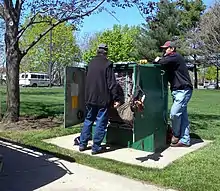
The serving area interface or service area interface (SAI) is an outdoor enclosure or metal box that allows access to telecommunications wiring.
Alternate names
Function
The SAI provides the termination of individual twisted pairs of a telephony local loop for onward connection back to the nearest telephone exchange (US: "central office" (CO)) or remote switch, or first to transmission equipment such as a subscriber loop carrier multiplexer and then to the exchange main distribution frame (MDF).
In the United Kingdom, the components from the PCP onwards to the customer are known as "D-side" (distribution side), and from the PCP back to the MDF as the "E-side" (exchange side). In the United States, the connection back to the MDF is known as the F2 (secondary distribution cable) and/or the F1 (main feeder cable) pairs.
SAIs are used in suburban and low-density urban areas, serving some of the same purposes that manholes do in high-density urban areas. Besides a cross connect point, they sometimes contain a DSLAM or more rarely a remote concentrator or both.
See also
References